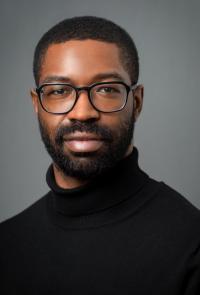Akinrinola Famuyide, MD, and Pamela Nguyen, MD, Appointed Co-Directors of Head and Neck Imaging
The Department of Radiology is very pleased to announce our new co-directors of head and neck imaging, Akinrinola (Akin) Famuyide, MD and Pamela Nguyen, MD.
Famuyide and Nguyen, both assistant professors of radiology at Columbia University Irving Medical Center (CUIMC), have led the department's head and neck imaging service for more than a year. They collaborate closely with CUIMC's otolaryngologists, skull base neurosurgeons, neurologists, radiation oncologists, ophthalmologists, and oral maxillofacial surgeons, among others. This appointment signals to all CUIMC clinicians that we have a reliable team who dedicate the majority of their practice to head and neck imaging.
"We want to offer the highest quality imaging and interpretation for head and neck diseases to our clinicians,” said Nguyen. “We are excited to continue to expand the department's head and neck imaging service."
Nguyen joined the Department of Radiology faculty in 2016 and Famuyide in 2020—both in the Division of Neuroradiology. In addition to clinical responsibilities, Nguyen also serves as the program director for the Neuroradiology Fellowship.
Q & A with Dr. Famuyide and Dr. Nguyen
What's new in head and neck imaging at Columbia?
Nguyen: There are many new minimally invasive ear and skull base surgery techniques, and they require imaging, so we are increasingly diagnosing conditions and mapping out pathology to create to help the surgeons create their operative plan. Dr. Famuyide is also performing ultrasound and CT guided head and neck biopsies, a service that we've recently started offering to our ENT surgeons, ophthalmologists, and skull base surgeons. In the past they would sometimes have to resort to more invasive open procedures to biopsy certain lesions, which involve a great deal of risk. But now Dr. Famuyide can do them under image guidance with just a small needle.
Famuyide: Overall, it's a constantly expanding subspecialty. We're continually figuring out new and better ways to image the area so that we can better evaluate, monitor, and evenutally intervene in minimally invasive ways on diseases of the head and neck. There are new imaging protocols and techniques that help us better image this anatomically complex area.
Why does head and neck imaging have its own section within neuroradiology?
Famuyide: Head and neck imaging has many unique aspects: unique anatomy and unique diseases that affect the head and neck. The field has grown so much that it now requires really specialized expertise to be able to manage the complexity of diseases that affect the area.
Nguyen: When you think of "neuro", you think of brain and spine. But head and neck encompasses oropharyngeal diseases, the oral cavity, audiologic diseases, the orbits, the face, teeth, and the sinuses. Because the anatomy overlaps so much with the brain, head and neck falls best within neuroradiology, but it's really almost its own thing.
What are your responsibilities as co-directors of head and neck imaging?
Nguyen: We read all head and neck imaging at CUIMC and provide consultations for complex cases requested by radiologists and clinicians from other NewYork-Presbyterian and CUIMC sites that don't have a dedicated head and neck radiologist.
Famuyide: We also attend and help direct multiple clinical conferences, and we manage the head and neck imaging protocols. We are also responsible for the education of residents and fellows in head and neck imaging.
What do you love about head and neck imaging?
Famuyide: It's a humbling field in terms of the opportunity to keep learning throughout your career, so it keeps you motivated and on top of your game. There are so many ways to continue to evolve the field, and so there are a lot of opportunities for someone who's young in their career. I also like the fact that it’s really unique. A lot of people don't want to do head and neck imaging. You get to really carve out an area and become an expert.
Nguyen: I love the very unique and intense anatomy of the head and neck, and the related disease processes. I also think the relationship with the ENT department is great here. The clinicians at Columbia are excellent, and as a result they offer us really interesting pathology.
What are you looking forward to as co-directors of head and neck imaging at Columbia?
Nguyen: I'm looking forward to optimizing image quality and streamlining protocols across the institution. It's a big institution with many sites and not everything is always uniform. We want to improve that for head and neck.
Famuyide: We also hope to expand our research programs. There is plenty of opportunity and sometimes choosing what to pursue can be the challenge. We hope to expand our manpower and engage in more of these types of endeavors.
Nguyen: And then there's the procedures. That's a huge growth potential area that Dr. Famuyide is developing.
Famuyide: I want Columbia to be the unequivocal best place for head and neck imaging in the country!


